One year after the swearing in of the Morales government in Bolivia it is possible to make a sober balance sheet of the situation. Morales has attempted to carry out some reforms while trying to appease the oligarchy. The masses are drawing conclusions: that compromise is not possible. The struggle must go all the way.
Masses go onto the offensive, MAS government delays taking action
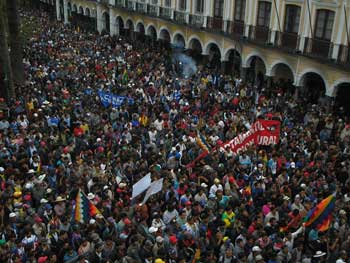 |
| Popular assembly in Cochabamba on January 16 |
On Tuesday, January 16th, a massive cabildo abierto (popular assembly) in Cochabamba, Bolivia's third largest city, decided to remove the prefecto (regional governor) and forced the consejeros departamentales (regional councillors) to install a people's prefecture. In doing so the masses, who have been on the streets since the beginning of the year, went over the heads of MAS aligned leaders of many of the peasant and trade union organisations and directly against the advice of the MAS government which recommended calm, negotiation and keeping everything within the legal framework.
This was the highest point of a developing mass movement for the resignation of the prefectos of La Paz and Cochabamba who have sided with the opposition prefectos of Santa Cruz, Beni, Pando and Tarija (the lowlands crescent of Bolivia) in their struggle for autonomy from the MAS national government and to defend their right of veto in the Constituent Assembly.
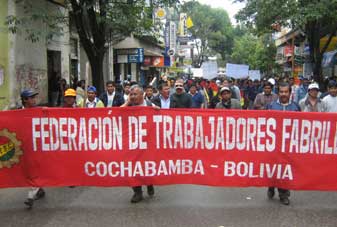 One year after the election of Evo Morales (who was sworn in on January 22, 2006) the recent events in Cochabamba and La Paz encapsulate the contradictions facing his government. Morales was elected with a massive majority as a by-product of a long period of revolutionary struggle by the workers and peasants, going back to the year 2000. This upsurge of the mass movement went as far as posing the question of power on at least two occasions: the Red October of 2003 when the movement overthrew the hated president Goni Sánchez de Lozada; and the May-June 2005 movement which overthrew Carlos Mesa and prevented the oligarchy from imposing Vaca Diez as his replacement. But at the crucial moment the leaders of the movement did not know what to do and the question of power was not resolved in favour of the workers. This allowed for the whole movement to be channelled back into parliamentary politics and to express itself in the massive vote for Evo Morales in December 2005.
One year after the election of Evo Morales (who was sworn in on January 22, 2006) the recent events in Cochabamba and La Paz encapsulate the contradictions facing his government. Morales was elected with a massive majority as a by-product of a long period of revolutionary struggle by the workers and peasants, going back to the year 2000. This upsurge of the mass movement went as far as posing the question of power on at least two occasions: the Red October of 2003 when the movement overthrew the hated president Goni Sánchez de Lozada; and the May-June 2005 movement which overthrew Carlos Mesa and prevented the oligarchy from imposing Vaca Diez as his replacement. But at the crucial moment the leaders of the movement did not know what to do and the question of power was not resolved in favour of the workers. This allowed for the whole movement to be channelled back into parliamentary politics and to express itself in the massive vote for Evo Morales in December 2005.
The way in which Morales and the MAS came to power created a peculiar relationship between the mass movement of workers and peasants and the government. On the one hand, support for Morales was overwhelming (more than 53% nationally), particularly in those areas which had been the centre of the revolutionary struggle in the preceding years (more than 70% in areas of El Alto, 66% in La Paz and 64% in Cochabamba). But at the same time this support was linked to the demands of the movement, it was not simply a vote for Evo Morales, but a vote for Evo as the representative of the demands of the movement, the so-called October Agenda, which included key points such as the nationalisation of hydrocarbons, land reform, putting on trial Goni Sanchez de Lozada (responsible for the killing of nearly 100 demonstrators) and the convening of a Constituent Assembly.
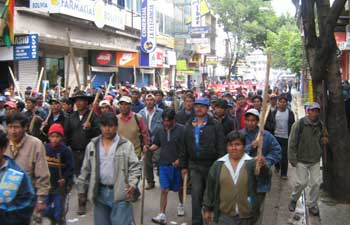 For the last twelve months the government has tried to move forward on some of these issues while also trying not to upset the oligarchy and the multinationals too much, taking steps forward and then retreating in the face of threats by the capitalists and landowners, calling mass mobilisation but always keeping it within the framework of parliamentary democracy. This was the case with the hydrocarbons. The government declared their nationalisation and sent the army into the oil and gas fields (see Bolivian government takes back control of hydrocarbons). Although this was only a partial measure which did not imply expropriation of the multinationals, they reacted immediately and applied relentless pressure on Evo and his ministers (using amongst other levers, the muscle of the mighty neighbour Brazil) so that the details of the implementation of the decree would not include any actual takeover. This finally led to the resignation of Hydrocarbons Minister Soliz Rada who said he was not prepared to budge (see his resignation letter).
For the last twelve months the government has tried to move forward on some of these issues while also trying not to upset the oligarchy and the multinationals too much, taking steps forward and then retreating in the face of threats by the capitalists and landowners, calling mass mobilisation but always keeping it within the framework of parliamentary democracy. This was the case with the hydrocarbons. The government declared their nationalisation and sent the army into the oil and gas fields (see Bolivian government takes back control of hydrocarbons). Although this was only a partial measure which did not imply expropriation of the multinationals, they reacted immediately and applied relentless pressure on Evo and his ministers (using amongst other levers, the muscle of the mighty neighbour Brazil) so that the details of the implementation of the decree would not include any actual takeover. This finally led to the resignation of Hydrocarbons Minister Soliz Rada who said he was not prepared to budge (see his resignation letter).
The attempt by the government to implement a progressive but limited land reform, which would only touch "unproductive latifundia", and the beginning of the distribution of some state owned land, led to a furious response on the part of the landowning oligarchy (mainly based in the lowlands Departments of the "crescent" and with their political stronghold in Santa Cruz), which made open and public appeals for the setting up of armed white guards to defend private property of the land. The Union Juvenil Cruceña has become the paramilitary fascist wing of the oligarchy, carrying out attacks and intimidation against peasant, trade union and MAS activists in this region.
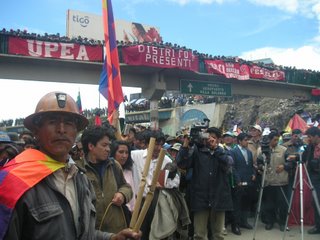 |
| Popular Assembly in El Alto |
In relation to the Constituent Assembly, vice-president García Linera (the main advocate within the government of the idea of Andean capitalism) made a deal with the opposition in order to placate them. The agreement was for the opposition to limit their demands for autonomy (a completely reactionary demand which basically means their right not to obey the rulings of the democratically elected national government and to keep control over the natural resources, concentrated in the Departments where they have a majority) and in exchange they would be given a de facto right of veto at the Constituent Assembly by instituting a 2/3 majority vote to pass any decisions. What happened was that although the MAS once again got a majority of more than 50% in the Assembly, they did not get the necessary 2/3 to take any decisions.
In an attempt to break this deadlock, at the end of August 2006, the wings of the MAS more linked to the peasant organisations, led by Ramon Loayza, a former leader of the peasant union CSUTCB and head of the MAS group in the Constituent Assembly, passed a set of rules which would allow the voting of the new constitution by a majority of 50% plus one. This led to physical clashes in the Constituent Assembly and its boycott on the part of the representatives of the oligarchy. The MAS government appealed for mass mobilisations, but these were not part of a general plan, rather they were more like the opening and closing of the tap of mobilisation from above.
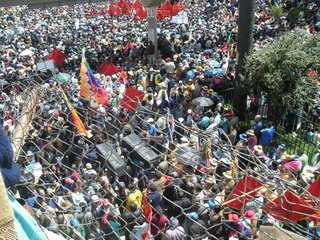 All these vacillations of the government encouraged the right wing and sowed confusion among the masses that support the government. The oligarchy was able to regain lost terrain and went onto the offensive. They launched a campaign of mass mobilisations in Santa Cruz and the other "crescent" departments, demagogically using the banner of "autonomy" and whipping up a reactionary campaign against "the Communist Indian Evo", the "interference of Venezuela and Cuba", etc., much in the same way in which the oligarchy in Venezuela mobilised the masses of the middle classes in the run up to the April 2002 coup and the December 2002 lock-out. In Santa Cruz trade union and peasant activists who tried to resist and organise counter-mobilisations were met with heavy repression on the part of the police and paramilitary gangs. This campaign included "strikes" (in reality bosses' lock-outs) and even a "hunger strike" on the part of the leaders of the "Civic Committees" of these regions in La Paz in December.
All these vacillations of the government encouraged the right wing and sowed confusion among the masses that support the government. The oligarchy was able to regain lost terrain and went onto the offensive. They launched a campaign of mass mobilisations in Santa Cruz and the other "crescent" departments, demagogically using the banner of "autonomy" and whipping up a reactionary campaign against "the Communist Indian Evo", the "interference of Venezuela and Cuba", etc., much in the same way in which the oligarchy in Venezuela mobilised the masses of the middle classes in the run up to the April 2002 coup and the December 2002 lock-out. In Santa Cruz trade union and peasant activists who tried to resist and organise counter-mobilisations were met with heavy repression on the part of the police and paramilitary gangs. This campaign included "strikes" (in reality bosses' lock-outs) and even a "hunger strike" on the part of the leaders of the "Civic Committees" of these regions in La Paz in December.
As a counter-response the MAS mobilised the peasant and trade union organisations in demonstrations against the prefectos of these Departments, and particularly against the prefectos of Cochabamba and La Paz, who now came out openly in favour of "autonomy" and sided with the oligarchy. This enraged the masses in these two Departments who had voted overwhelmingly for Morales. The MAS government viewed these mobilisations as a way of gaining a stronger position at the negotiating table. Once again, trying to maintain everything within the narrow limits of parliamentary democracy, Evo Morales announced the passing of a new law which would provide for recall referenda at all levels (from local councillors to the president, including the prefectos). This was an attempt to give a constitutional solution to the deadlock.
But the situation precipitated in Cochabamba on January 8th when the tens of thousands of people, workers, peasants, trade unionists, students, who had been besieging the city demanding the resignation of the hated prefecto Reyes Villa, were met with heavy repression on the part of the police and paramilitary gangs. Two cocalero peasants were killed and dozens injured. This enraged the masses even more and led to the partial burning down of the Prefectura building. This was a turning point since for the masses it was no longer a question of putting pressure on Reyes Villa and waiting for a recall referendum in the future; they wanted to get rid of him then and there. "The leaders have been overtaken and they have lost control of the ranks," said vice-minister Alfredo Rada, who belongs to the moderate wing of the MAS.
After more repression on January 11, on the 12th there was a new massive cabildo abierto called by the Departmental Workers' Union (COD) which includes workers' and peasants' organisations. The mood was extremely angry and tens of thousands of workers and peasants, armed with sticks and stones shouted, "the people united, will never be defeated". One of the leaders of the COD promised that "faced with the killings we will respond with ‘community justice'", and one of the cocalero leaders demanded that Reyes Villa "be hanged like Saddam Hussein".
The will of the masses was clear and they marched day in day out and attended massive rallies demanding the overthrow of Reyes Villa and that he be brought to trial. Reyes Villa fled to Santa Cruz fearing for his life. The aim of the government was different. Garcia Linera repeated throughout the movement that Reyes Villa had been elected by popular vote and that this had to be respected. Evo Morales asked "the social movements not to be vengeful" and to "respect human life and look for solutions within the framework of democracy".
In this really heated situation a new cabildo abierto was called on Tuesday 16th. Everybody expected the rally to take the decision to overthrow Reyes Villa and replace him with a new prefecto. This was the reason why the meeting had been called and the people were becoming tired of marching every day without a solution being arrived at. Thousands of those present at these cabildos are cocaleros travelled from miles away and had been sleeping in precarious conditions in trade union offices and squares in Cochabamba for days. But the leaders of some of the peasant and trade union organisations, aligned with the MAS leadership, were not prepared to break with the "democratic legality" and attempted to get the meeting to pass a vague resolution that simply said that Reyes Villa was no longer the prefecto but that a constitutional solution would be sought.
The masses took direct action, occupied the meeting room where the Departmental Council (with a MAS majority) was meeting, and forced the departmental councillors to appoint a new People's Prefectura headed by Tiburcio Herradas. Cochabamba Departmental Councillor Diaz Estrada described the events in this way: "We were attacked and forced to convene a session to elect a new prefect. The councillors explained that this was illegal, but there were threats of lynching and we were forced to install the new prefect". A new departmental government was instituted composed of delegates from 15 organisations. As a result of this decision the leaders of some of the cocalero organisations appealed to their ranks to leave the square.
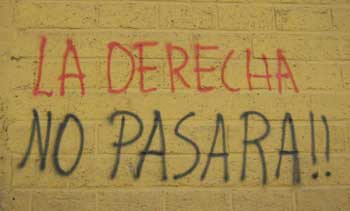 Even today, it is not very clear what the real situation is in Cochabamba. The MAS government, mainly through vice-president Garcia Linera, has come out clearly against the decision of proclaiming a new "peoples' prefect". In a press conference he asked the media to "understand that one thing is a cabildo of between 80,000 and 100,000 people, and another is the firm decision of the Executive Power to recognise the legality of the democratically elected authorities". He insisted that Reyes Villa was still the prefect of Cochabamba (even though he is not even in the Department) and appealed to the prefect and the social organisations "to sit around a table and bring their positions closer through dialogue".
Even today, it is not very clear what the real situation is in Cochabamba. The MAS government, mainly through vice-president Garcia Linera, has come out clearly against the decision of proclaiming a new "peoples' prefect". In a press conference he asked the media to "understand that one thing is a cabildo of between 80,000 and 100,000 people, and another is the firm decision of the Executive Power to recognise the legality of the democratically elected authorities". He insisted that Reyes Villa was still the prefect of Cochabamba (even though he is not even in the Department) and appealed to the prefect and the social organisations "to sit around a table and bring their positions closer through dialogue".
Meanwhile, a similar movement has been developing in El Alto and in La Paz against the prefect of La Paz, Jose Luís Paredes, who has also come out on the side of the oligarchy and against the government, and in support of the struggle in Cochabamba. Thus, on January 15th, a massive cabildo called by the Regional Workers' Union (COR), the Federation of Neighbourhood Juntas of El Alto, and other workers, peasant and cocalero organisations agreed to a six point resolution which is worth reproducing in full:
Resolutions from open town meeting convoked by the Federation of Neighbourhood Committees of El Alto (FEJUVE), and the Regional Workers Central of El Alto (COR-El Alto), held in El Alto, January 15, 2007:
1. We, the people of El Alto declare ourselves to be in a war to the death until we achieve the resignation of the neoliberal prefects and mass murderers, Manfred Reyes Villa and Jose Luis Paredes. At the same time, we support unconditionally the cocaleros and peasants from Cochabamba who have been forcefully repressed.
2. We give a deadline of 48 hours to the current prefect of the department of La Paz, Jose Luis Paredes, to voluntarily resign from his position, otherwise he will be expelled together with his collaborators through pressure and other acts of struggle.
3. The consistent struggle of the altenos will not stop until we defeat all the neoliberal prefects and their repressive and fascist apparatus, such as the civic committees, youth unions and prefects from the "half moon" [crescent].
4. The people of El Alto declare themselves to be in favour of a struggle without truce for the unity of Bolivia.
5. We, the people of El Alto declare that we are on our feet and are prepared for a struggle to achieve the definitive defeat of the oligarchy in order to build our own government.
After the declaration of the "people's prefect" in Cochabamba, the organisations in El Alto at an Enlarged Meeting of Representatives agreed to call a "general strike with mobilisations" on Monday 22. The six point resolution included the demand for the resignation of the prefect, the taking over of the buildings of the Prefectura and the seizing of Paredes' wealth, as well as the expulsion of any leaders that betray the movement. They also placed the responsibility for any deaths or injuries caused during the mobilisation on the shoulders of the prefect, and called for the taking over of the means of communication if they lie about or distort what the movement is doing.
This resolution, again, goes directly against the line of the MAS government, with the minister of Social Movements Alfredo Rada, appealing directly to the El Alto organisations to "change their attitude and look for a legal solution to their demands", meaning the recall referendum.
Regardless of how long this "people's prefect" lasts and how the current situation is resolved in Cochabamba and El Alto, it does reflect something extremely significant. The fact is that, faced with the provocations of the right wing, the masses are becoming restless and are starting to take matters into their own hands. In this respect the policy of the MAS leaders, and particularly that of Garcia Linera, is criminal, even from the narrow point of view of the survival of the MAS government itself. The only way to answer the counter-revolutionary provocations of the oligarchy is through the mass mobilisation of the workers and peasants who voted for Evo Morales, and their revolutionary enthusiasm can only be unleashed if they see a government that is on their side and that firmly stands up to the oligarchy and responds to the just demands of workers and peasants. Any vacillation and compromise with the oligarchy will only have the effect of sowing confusion and disillusionment in the mass movement, and will encourage the oligarchy to go onto the offensive as the whole experience of the last 12 months clearly demonstrates.
As we said 12 months ago (Bolivia after the election victory of the MAS - Morales cannot serve two masters) there are only two ways forward for the Morales government. One is to base itself on the mass mobilisation and organisation of the workers and peasants who voted for him, to move forward decisively to put an end to the rule of the capitalists, the landowners and the multinationals; the other is to make concessions to the oligarchy, lose the support of the rank and file and be removed in a violent manner. The dream of Andean capitalism cannot be realised. There is no possibility of development of Bolivia within the framework of capitalism. This should be the main conclusion that the movement should draw from the first year of Morales' government.
The ruling class is well aware of this. They are arming themselves to the teeth and are gathering support to resist even the smallest of reforms that the MAS government wants to introduce. As in Venezuela, where the ruling class organised a military uprising against the introduction of the most moderate of reforms, the only way of saving the MAS government is through the mass mobilisation of workers and peasants in the streets. These have demonstrated again and again their willingness to sacrifice all to achieve their aim, a government of their own with control over the country's natural resources.
As in Venezuela, the only way forward is socialism, and this can only be based on the revolutionary initiative and organisation of the masses. The events of October 2003 and May-June 2005 showed clearly that the mobilised forces of the workers and peasants can crush the will of the oligarchy. The stakes are very high. There is no room for vacillation.
See also:
- Bolivian miners defend nationalised industry – 16 die in clashes by Jorge Martin (October 11, 2006)
- Bolivia at the crossroads by Peppe Letizia and Leonor Pereira (October 11, 2006)
- Bolivian government takes back control of hydrocarbons by Jorge Martin (May 5, 2006)
- Bolivia after the election victory of the MAS - Morales cannot serve two masters by Jorge Martin (January 10, 2006)
- Morales wins massive vote in Bolivian elections - Which way will he go now? by Jorge Martin (December 20, 2005)
- Bolivian elections - What position should the Marxists take? by Jorge Martin (December 16, 2005)
- Bolivia: new president tries to divert the movement towards parliamentary trap by Jorge Martin (June 13, 2005)
